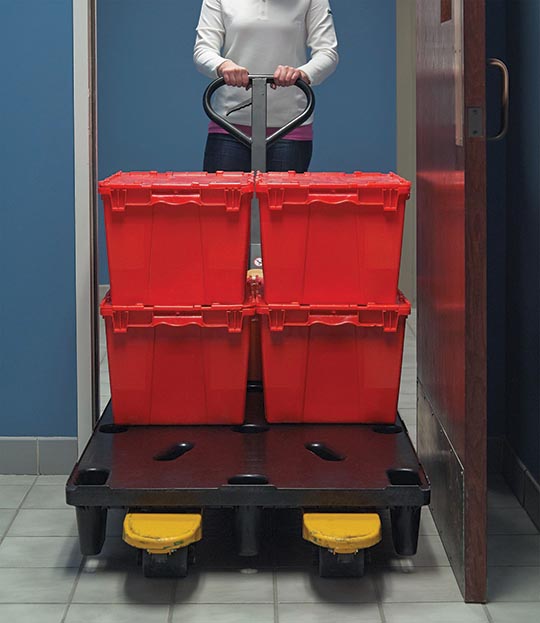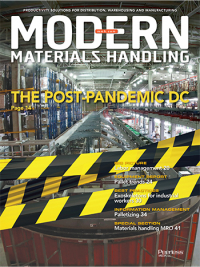6 pallet trends to watch in 2020
Pallet manufacturers reveal the top trends affecting the way they make and sell their products right now, and outline the positive impacts these shifts are having on the companies that use their pallets.
Whether they’re carbon-neutral, sanitized, made in the U.S.A., or ready to be rolled out onto the retail store floor, the “new wave” of pallets sticks to its predecessors’ core functions—stacking, storing, protecting and transporting products—while adding a few new twists meant to satisfy the modern customer’s needs.
With Covid-19, social distancing rules and workplace shutdowns affecting the business environment in 2020, pallets are playing a critical supporting role in the smooth running of the supply chain. “Pallet purchasing trends and quantities are changing during this period of uncertainty,” says Gary Sharon, vice president at Litco. “Even with some markets softened due to decreased demand, we’ve had a steady supply of pallet orders.”
At ORBIS, product manager Jordan Rogers says that as the business world continues to adapt to the current challenges and operate in the post-Covid world, pallets will play an even bigger part in the overall supply chain. “We may not know what the future is going to look like, but pallets are going to be a big part of it because they are kind of the lifeblood of all industries,” says Rogers. “They are the true workhorses of the warehouse and DC.”

6 shifts in the pallet industry to watch
Here are six trends that manufacturers are seeing right now and how they believe these shifts will affect the pallet’s role in the overall supply chain.
1.) Cleaner, sanitized pallets
Some pallet users now have a high concern about their pallet’s hygiene and chain of custody and, as such, are looking for “clean” pallets. “We are experiencing an increased demand for our engineered wood pallets, especially from companies that typically purchase used pallets,” says Sharon, whose firm has been making sanitized, nestable pallets for more than four decades.
The process first dries the wood fiber down to 3% moisture content, which kills all of the pests, pathogens, listeria and mold. After a resin binder is added, the materials are then hot pressed in a mold at 350°F. The high temperature automatically sanitizes the surfaces, with the finished pallet coming out of the press at 8% moisture content. “It’s a naturally clean pallet when it’s manufactured, opposed to maybe a used, repaired wood pallet, where no one knows where it’s been or what’s touched it,” Sharon says. “This process also leaves the pallets ready for export per IPPC-ISPM15, without any additional heat-treating and special license stamps.”
2.) Made in the U.S.A.
According to Sharon, companies are leaning toward a preference to purchase products made in the United States. The global pandemic appears to have accelerated this trend, with a greater number of companies trying to support more U.S. manufacturing and American-made products.
Made domestically, for example, Litco pallets are certified as sustainable and manufactured from 100% regionally sourced, environmentally responsible raw materials. “People are saying, ‘well maybe we need to make more things here in the United States,’” Sharon says, “with the goal of securing the supply chain and being able to better monitor quality and the hygienic aspect of pallet production.”
3.) Point-of-purchase (POP) display pallets.
Pallets that can be unloaded from a truck and taken straight onto the store floor have been around for a while, but their use is growing in the current business environment. Even before Covid-19 reared its head, retailers were working to improve efficiencies at the store level, where POP display pallets are often found in convenience stores, which rely heavily on foot traffic (versus online ordering with delivery or buy online/pick up in store).
Now, with social distancing rules in place and sanitization/disinfecting processes ramped up, not having to touch a pallet has become a new selling point. “POP display pallets allow retailers to minimize product touches by loading directly onto that pallet at the DC,” says Rogers, “and then sending the pallet to the store, where they roll it right out into the aisle and unpack it.” Once the pallet is emptied, it can be sent back to the DC or warehouse for replenishment.
4.) Pallets that support smaller-format stores.
With retailers opening more smaller format and specialized stores, pallet makers are reimagining their product lines to support this trend. In many cases, the movement is driven by the urbanization trend. “A lot of the traditional big box stores are moving into urban areas, with retailers like Target moving to small-format stores where smaller product loads have to get through smaller doors (due to a lack of traditional loading docks, for example),” says Rogers, whose company makes a line of small format options that include a 42 x 30-inch “skinnier pallet” that enables more efficient deliveries for these small-format stores.
This design makes the delivery process faster and more efficient for drivers, who don’t have to de-stack pallets out in the parking lot and then bring the goods in on their carts. “They can actually just use a hand truck to bring in these skinnier pallets, which are only 30 inches wide, right through the front door,” says Rogers. This has a direct impact on retailers’ labor costs in that fewer drivers are required. Even better, the drivers that are working generally have a more enjoyable experience. “Driver retention goes up when retailers start utilizing smaller-format pallets that can also serve as POP displays because they’re brought directly from the DC into the store,” Rogers adds.
5.) A collaborative approach to sustainability.
There isn’t a corner of the business world that hasn’t been touched by the push to operate more sustainably, and pallets are no exception to the rule. According to Rogers, pallet makers like ORBIS continue to market the value of investing in plastic pallets, which—citing a Virginia Tech lifecycle test—he says can handle 10 to 20 times the number of trips that wooden pallets can manage. “There’s a larger upfront investment required for plastic pallets, but the user’s costs over the life of a pallet are greatly reduced because they’re recyclable,” says Rogers. This recyclability helps support an organization’s overall commitment to operating more sustainably. At CHEP, Jason Adlam, vice president of new business development, says he’s seeing more companies ramp up their sustainability goals and initiatives right now, with an eye on improving their operations in these areas. Companies that have already implemented sustainability initiatives within their own four walls, Adlam says, are now going to the next level and making incremental step changes toward sustainability, removing waste from their transportation networks, and working with their pallet providers to achieve these and other goals.
“The only way to be successful in that space is to adopt a collaborative mindset as an organization,” says Adlam, “and bring in all of your trading partners to help you toward those sustainability goals and objectives.”
6.) Carbon-neutral pallets.
Also in the area of sustainability, more companies are calculating their carbon footprints and working to reduce them to zero. To help its customers achieve this goal, CHEP has developed a carbon neutral half-pallet. According to Adlam, the 40 x 24-inch pallet has been well received by customers that are striving to reduce their own overall carbon footprints. “The product is pretty innovative from a sustainability standpoint because it’s the first half-pallet product that we’ve created that’s fully carbon neutral,” says Adlam.
 To make it, the company analyzed the half-pallet’s overall carbon footprint, determined its total carbon usage, and then purchased carbon offset credits (these credits allow individuals and companies to invest in environmental projects to balance out their own carbon footprints). “Companies using this pallet can also account for any carbon benefits and sustainability benefits for their [individual] reporting structures,” says Adlam.
To make it, the company analyzed the half-pallet’s overall carbon footprint, determined its total carbon usage, and then purchased carbon offset credits (these credits allow individuals and companies to invest in environmental projects to balance out their own carbon footprints). “Companies using this pallet can also account for any carbon benefits and sustainability benefits for their [individual] reporting structures,” says Adlam.
When shipping half-pallets to retailers, they can take it off the truck and move it right out onto the store floor without having to touch any of the product that’s stored on it. “It’s fully display-ready,” says Adlam, who sees less chance for product damage and the need for fewer “hands on deck” to manage the pallets as two additional benefits of using the carbon neutral half-pallet.
The sustainability benefits are equally as impressive: Adlam says one major sugar manufacturer used the half-pallets to remove about 231,000 pounds of carbon dioxide from its supply chain. “It’s a win-win for the manufacturer and the retailer from a sustainability standpoint,” he adds, “and the first and only one of its kind, to our knowledge.”
Companies mentioned in this article:

Article Topics
Shipping Pallets News & Resources
Two voices of reason on pallet materials PLA Solutions Video - Stay on Top of It All Pallet recycler and services company PLA appoints Steve Clark as CEO Cobot as key ingredient for palletizing efficiency CHEP appoints Xavier Garijo to newly created CEO Americas position Pallet company Kamps announces executive team changes PLA names Jenny Bedard as new CFO More Shipping PalletsLatest in Materials Handling
Geek+ and System Teknik deploy PopPick solution for pharmacy group Med24.dk Beckhoff USA opens new office in Austin, Texas Manhattan Associates selects TeamViewer as partner for warehouse vision picking ASME Foundation wins grant for technical workforce development The (Not So) Secret Weapons: How Key Cabinets and Asset Management Lockers Are Changing Supply Chain Operations MODEX C-Suite Interview with Harold Vanasse: The perfect blend of automation and sustainability Consultant and industry leader John M. Hill passes on at age 86 More Materials HandlingAbout the Author
Subscribe to Materials Handling Magazine

Find out what the world's most innovative companies are doing to improve productivity in their plants and distribution centers.
Start your FREE subscription today.
April 2024 Modern Materials Handling

Latest Resources












